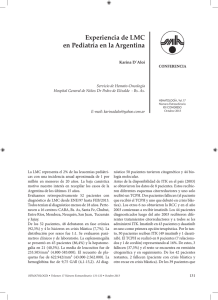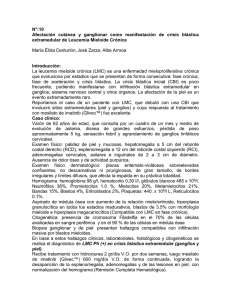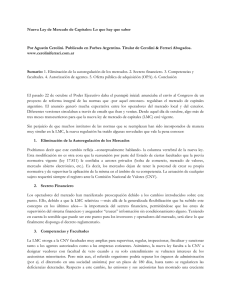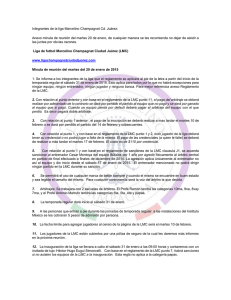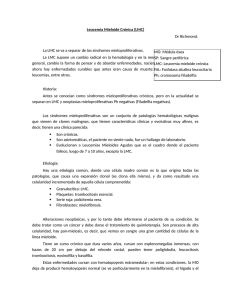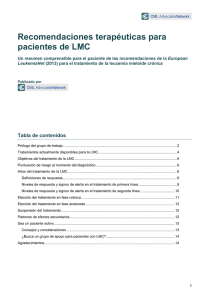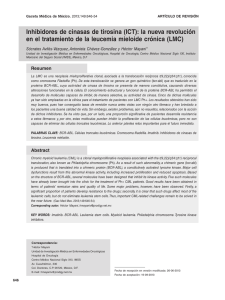LMC - Aula Clínic
Anuncio
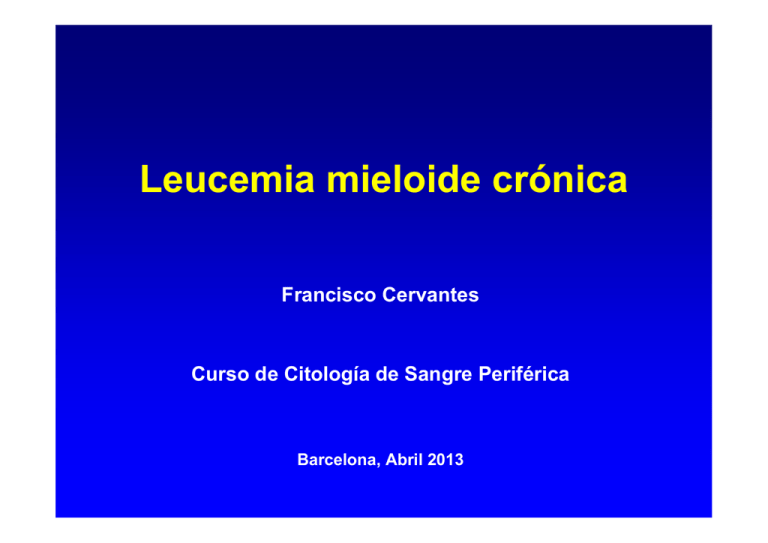
Leucemia mieloide crónica Francisco Cervantes Curso de Citología de Sangre Periférica Barcelona, Abril 2013 LMC: definición Neoplasia mieloproliferativa crónica clonal con origen en una stem cell pluripotencial común a las tres series hemopoyéticas, reordenamiento proliferación cuya del alteración gen caracterizada BCR-ABL) por molecular (el origina una una marcada leucocitosis granulocítica con hiperplasia granulocítica de la médula ósea. LMC: aspectos clínicos • Edad mediana al diagnóstico: 55 años • Ligero predominio masculino • Sintomatología inicial: Síntomas constitucionales Molestias abdominales por esplenomegalia Síndrome anémico Otros (dolores óseos, gota, hemorragias) Ausencia de síntomas 20% 20% 10% < 5% 55% • Exploración física: Esplenomegalia Hepatomegalia 45% 10% LMC: datos de laboratorio (I) • Sangre periférica: Leucocitosis granulocítica > 100 x 109/L < 50 x 109/L Basofilia y mielemia Trombocitosis Anemia Disgranulopoyesis (desgranulación, pseudo-Pelger) Eritroblastos circulantes Disminución FAG 50% 30% 45% 20% 90% • Bioquímica: aumento de LDH, ácido úrico y vitamina B12 LMC: citología de sangre periférica Fosfatasa alcalina granulocítica (FAG) LMC PV LMC: médula ósea Mielograma: Aumento celularidad hemopoyética Hiperplasia granulocítica Hiperplasia megacariocítica Células pseudo-Gaucher, histiocitos azul marino Disminución hierro medular y sideroblastos: 80% Biopsia medular: Aumento de la celularidad y disminución de la grasa Hiperplasia granulocítica Hiperplasia megacariocítica Fibrosis variable LMC: citología de médula ósea (I) LMC: citología de médula ósea (II) LMC: biopsia de médula ósea LMC: datos de laboratorio (III) – Citogenética (MO): Cromosoma Filadelfia (Ph) = t(9;22) 95% – Análisis molecular (SP): Southern blot, PCR Reordenamiento del gen BCR-ABL Tránscrito b3a2 b2a2 60% 40% Cromosoma Filadelfia (Ph): translocación t(9;22)(q34;q11) 9 9q+ 22 Ph (22q-) bcr abl bcr-abl PROTEÍNA BCR-ABL CON ACTIVIDAD TIROSINOCINASA AUMENTADA (p210) Reordenamiento BCR (Southern blot) Tránscritos BCR/ABL (RT-PCR) Efectos celulares BCR-ABL BCR-ABL DISMINUCIÓN ADHESIÓN PROLIFERACIÓN FENOTIPO MALIGNO INHIBICIÓN APOPTOSIS FASE CRÓNICA 45% 55% F. ACELERACIÓN CRISIS BLÁSTICA LMC: formas especiales de presentación (I) • LMC de inicio trombocitémico (5%) - Leucocitosis moderada (~20 x 109/L) Mielemia y basofilia Trombocitosis > 1000 x 109/L Cromosoma Ph + y/o reordenamiento del gen BCR/ABL • LMC Ph-negativa (5%): • BCR/ABL+ (+ 2-3%) = Igual que LMC Ph+ • BCR/ABL-negativa (LMC atípica): - Edad avanzada Anemia intensa Ausencia de basofilia Visceromegalias progresivas Menor frecuencia de evolución a crisis blástica Supervivencia mediana: 1,5-2 años LMC: formas especiales de presentación (II) • Crisis blástica inicial (5%) - Blastos en SP/MO 20% y/o (blastos + promielocitos) 30% en SP ó 50% en MO + perfil característico LMC - Infiltración blástica extramedular • Variante neutrofílica de la LMC (<1%) - Leucocitosis neutrofílica sin mielemia - Cromosoma Ph + - Tránscrito e19a2 (c3a2) = proteína tirosinocinasa p230 LMC: diagnóstico diferencial • Reacción leucemoide (infección, neoplasia) • Mielofibrosis primaria (forma hiperproliferativa) • Leucemia mielomonocítica crónica (variante mieloproliferativa) • Síndrome hipereosinofílico idiopático • Leucemia neutrofílica crónica LMC: fase de aceleración (1) Definición: • Criterios diagnósticos: - Blastosis SP ó MO 10 - 19% - Basofilia 20% - Leucocitosis progresiva refractaria al tto. - Anemia y/o plaquetopenia no atribuibles al tto. - Anomalías citogenéticas adicionales • Datos clínicos: - Pérdida de peso - Fiebre y/o sudoración persistente - Dolores óseos - Esplenomegalia progresiva (2) Pronóstico: - Supervivencia actual: 2-4 años LMC: crisis blástica (I) (1) Definición: • Blastos en SP/MO 20% • Blastos + promielocitos 30% en SP ó 50% en MO • Infiltración blástica extramedular (2) Características clínicas: • Síntomas constitucionales • Dolores óseos • Infecciones, hemorragias • Esplenomegalia progresiva (3) Laboratorio: • Blastosis • Citopenias (anemia, plaquetopenia) • Otras alteraciones citogenéticas (60-80%): +8, iso(17q), +Ph, otras • LDH LMC: crisis blástica (II) Fenotipo: • Mieloide (60%) • Precedido por fase de aceleración en 50% enfermos • No respuesta a QT tipo leucemia aguda • Mediana supervivencia: 4 - 8 meses • Linfoide (25%) • • • • • • • Inicio brusco en la mayoría de casos Menor frecuencia de visceromegalias y basofilia Mayor infiltración MO Fenotipo B habitualmente Expresión frecuente de marcadores mieloides Respuesta a quimioterapia tipo LAL en 60% de casos Mediana supervivencia: 12 meses • Megacarioblástico (10 - 15%) • Eritroide (1%) LMC: crisis blástica mieloide MPO LMC: crisis blástica linfoide LMC: CB megacarioblástica PPO LMC: CB eritroide LMC-CB: alteraciones citogenéticas adicionales 47, XX, t(9;22)(q34;q11),+8 LMC: supervivencia según tratamiento Tratamiento Sin tratamiento Srv mediana* 2,5 Busulfán 4 Hidroxiurea 5 Interferón 6 Imatinib * Años 85% a los 8 años Results of Allo-SCT in CML 2000– 2003 1991– 1999 1980– 1990 Gratwohl et al., Haematologica 2006;91:513–521 Tratamiento de la LMC • Imatinib (Glivec) • Nuevos inhibidores de TC: Dasatinib y Nilotinib (si resistencia o intolerancia a imatinib) • Nilotinib y Dasatinib aprobados recientemente como tratamiento de 1ª línea • Trasplante alogénico de progenitores hemopoyéticos (si resistencia a inhibidores de TC) • Hidroxiurea: tratamiento paliativo • Interferón en embarazo) Mechanism of Action of Imatinib Bcr-Abl Bcr-Abl Substrate Substrate P P P ATP Imatinib P Y = Tyrosine P = Phosphate Goldman JM & Melo J, Lancet. 2000;355:1031-1032. Cumulative Best Response at 12 and 60 months on First-line Imatinib 100 96% 90 85% % responding 80 98% 92% 87% 69% 70 60 50 40 30 CHR MCyR CCyR 20 10 0 0 6 12 18 24 30 36 42 48 54 60 66 Months since randomization to Imatinib Druker et al, N EJM 2006 The BCR-ABL transcript levels mirror the number of residual leukemic cells 100 % Complete Hematologic Response 1010 Complete Cytogenetic Response 109 108 1% 0.1 % Major Molecular Response 107 106 10 % 0.01 % 0.001 % Undetectable transcripts BCR-ABL % Number of leukemic cells 1011 Mean value at diagnosis (according to the International Scale) 1012 Adapted from G Saglio EFS According to Molecular Response in IRIS Trial: 18-Month Landmark Analysis 95% P = .01 86% % Without Event 100 90 80 70 60 50 40 30 20 10 0 62% 58% BCR-ABL % (IS) ≤0.1% (n = 164) <=0.01% >0.1-1% (n = 47) >0.1-1% >1-10% (n = 25) >1-10% >10% (n = 13) 0 12 24 36 48 60 72 Months Since Start of Treatment 84 Hughes et al., ASH 2008 IRIS 8-Year Update Overall Survival (ITT) Imatinib Arm 100 90 % Alive 80 % , e vil A 70 Estimated overall survival at 8 years was 85% (93%, considering only CML related deaths) 60 50 40 30 20 Survival: deaths associated with CML Overall Survival 10 0 0 12 24 36 48 60 72 84 96 108 Months Since Randomization Deininger et al., ASH 2009 Poster presentation IRIS 8-Year Update Annual Event Rates Imatinib Arm 8 7.5 Event With Event, % 7 Loss of CHR, Loss of MCyR, AP/BC, Death during treatment 6 4 AP/BC 4.8 5 3.3 2.8 3 2 1.8 1.5 1.7 0.9 1 0 1.4 1 2 3 0.8 4 0.5 5 1.3 0.4 0.3 0 6 0 7 8 Year • • Estimated EFS at 8 years = 81% – 1 progression to AP/BC and 2 non-CML related deaths occurred in year 8 Estimated rate of freedom from progression to AP/BC at 8 years = 92% Deininger et al., ASH 2009 Poster presentation ENESTnd: Nilotinib vs Imatinib in CML-CP Nilotinib vs Imatinib Frontline: Progression to AP/BC on Core Treatment*† P = .0059 25 P = .0003 Number of Patients P = .0196 P = .0089 20 17 15 12 10 5 5 0 2 0.7% 3 1.1% 2 4.2% 0.7% 1.8% 6.0% Including Clonal Evolution Nilotinib 300 mg BID Nilotinib 400 mg BID Imatinib 400 mg QD *ITT population †Progression to AP/BC or death due to CML while on core treatment Data cut-off: 20Aug2010 Dasatinib vs. Imatinib Frontline: Transformation to Advanced Phase CML (ITT) 6 100 Dasatinib 100 mg QD Imatinib 400 mg QD 3,5 4 % 2,3 2 0 n/N 6/259 9/260 5 patients who achieved a CCyR transformed to AP/BP CML (2 dasatinib, 3 imatinib) No patient who achieved a MMR transformed to AP/BP CML to date Patients were followed for transformation for up to 60 days after the last dose of study drug; clonal evolution without additional criteria for AP CML was NOT counted as transformation
